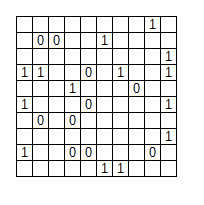Calcdoku problems, also called K-doku or Calcudoku were invented in 2004 by Japanese math teacher Tetsuya Miyamoto, who intended the puzzles to be an instruction-free method of training the brain. He used the Japanese name KenKen, which could be translated as ‘Cleverness’. In his classes, he sets aside about 90 minutes each week for solving puzzles. He believe that when students are motivated, they learn better, and he lets them do so at their own pace.
Other names used for this type of puzzle are Kendoku and Kashikoku naru Puzzle. The names KenKen and Kenduko are trademarked. Books are in Japan published by Gakken Co. In the USA the New York Times started publishing them in 2008. In my native Netherlands they appear regularly in both puzzle magazines and general magazines.
A calcudoku puzzle consists of a latin square – a latin square can have any size. If its size 4, the numbers 1 to 4 should appear exactly once in every rown and column exactky once. Similarly, if its size 5, the numbers 1-5 should appears exactly once in every row and column.
The square is subdivided into smaller areas, and the sum, product, difference or division result is given in the top left corner.
Here are two example puzzles.
1) 4×4**/*****

You can check your solution here
2) 5×5**/*****

You can check your solution here
3) 6×6****/*****
is an example puzzle, kindly offered by Jacques Min, who runs a website specialized in Calcudoku puzzles: :

Techniques for solving them:
* http://www.conceptispuzzles.com/index.aspx?uri=puzzle/calcudoku/techniques
*
You can check your solution here
New puzzles are published at least twice a month on Friday. Solutions are published after one or more weeks. You are welcome to remark on the difficulty level of the puzzles, discuss alternate solutions, and so on. Puzzles are rated on a scale of 1 to 5 stars.





















